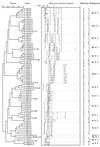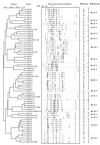Molecular characterization of the genera Proteus, Morganella, and Providencia by ribotyping
- PMID: 10449462
- PMCID: PMC85391
- DOI: 10.1128/JCM.37.9.2840-2847.1999
Molecular characterization of the genera Proteus, Morganella, and Providencia by ribotyping
Abstract
The so-called Proteus-Providencia group is constituted at present by three genera and 10 species. Several of the recognized species are common opportunistic pathogens for humans and animals. Different methods based on the study of phenotypic characters have been used in the past with variable levels of efficiency for typing some species for epidemiological purposes. We have determined the rRNA gene restriction patterns (ribotypes) for the type strains of the 10 different species of the genera Proteus, Morganella, and Providencia. Visual inspection of EcoRV- and HincII-digested DNA from the type strains showed remarkably different patterns for both enzymes, but EcoRV provided better differentiation. Both endonucleases were retained to study a large number of wild and collection strains belonging to the different species. Clinical isolates of Proteus mirabilis, Proteus penneri, Morganella morganii, and Providencia heimbachae showed patterns identical or very similar to those of the respective type strains, so that groups of related patterns (ribogroups) were found to correspond to the diverse species. On the contrary, distinct ribogroups were detected within Providencia alcalifaciens (two ribogroups with both enzymes), Providencia rettgeri (four ribogroups with EcoRV and five with HincII), Providencia stuartii (two ribogroups with EcoRV), Providencia rustigianii (two ribogroups with HincII), and Proteus vulgaris (two ribogroups with both enzymes). The pattern shown by the ancient P. vulgaris type strain NCTC 4175 differed considerably from both P. vulgaris ribogroups as well as from the newly proposed type strain ATCC 29905 and from any other strain in this study, thus confirming its atypical nature. Minor differences were frequently observed among patterns of strains belonging to the same ribogroup. These differences were assumed to define ribotypes within each ribogroup. No correlation was observed between ribogroups or ribotypes and biogroups of P. vulgaris, P. alcalifaciens, P. stuartii, and P. rettgeri. Since, not only different species showed different rRNA gene restriction patterns, but also different ribogroups and ribotypes have been found in the majority of the species, ribotyping would be a sensitive method for molecular characterization of clinical isolates belonging to the genera Proteus, Morganella, and Providencia.
Figures






Similar articles
-
Phylogenetic analysis of the genera Proteus, Morganella and Providencia by comparison of rpoB gene sequences of type and clinical strains suggests the reclassification of Proteus myxofaciens in a new genus, Cosenzaea gen. nov., as Cosenzaea myxofaciens comb. nov.Int J Syst Evol Microbiol. 2011 Jul;61(Pt 7):1638-1644. doi: 10.1099/ijs.0.021964-0. Epub 2010 Aug 13. Int J Syst Evol Microbiol. 2011. PMID: 20709916
-
Providencia rustigianii: a new species in the family Enterobacteriaceae formerly known as Providencia alcalifaciens biogroup 3.J Clin Microbiol. 1983 Jun;17(6):1057-60. doi: 10.1128/jcm.17.6.1057-1060.1983. J Clin Microbiol. 1983. PMID: 6874899 Free PMC article.
-
Genetic and biochemical diversity of ureases of Proteus, Providencia, and Morganella species isolated from urinary tract infection.Infect Immun. 1987 Sep;55(9):2198-203. doi: 10.1128/iai.55.9.2198-2203.1987. Infect Immun. 1987. PMID: 3623698 Free PMC article.
-
Bacteraemia due to tribe Proteeae: a review of 132 cases during a decade (1991-2000).Scand J Infect Dis. 2003;35(2):98-103. doi: 10.1080/0036554021000027015. Scand J Infect Dis. 2003. PMID: 12693558 Review.
-
Classification, identification, and clinical significance of Proteus, Providencia, and Morganella.Clin Microbiol Rev. 2000 Oct;13(4):534-46. doi: 10.1128/CMR.13.4.534. Clin Microbiol Rev. 2000. PMID: 11023955 Free PMC article. Review.
Cited by
-
Isolation and Molecular Identification and Antimicrobial Susceptibility of Providencia spp. from Raw Cow's Milk in Baghdad, Iraq.Vet Med Int. 2020 Nov 19;2020:8874747. doi: 10.1155/2020/8874747. eCollection 2020. Vet Med Int. 2020. PMID: 33456748 Free PMC article.
-
Comparative Epidemiology and Resistance Trends of Proteae in Urinary Tract Infections of Inpatients and Outpatients: A 10-Year Retrospective Study.Antibiotics (Basel). 2019 Jul 11;8(3):91. doi: 10.3390/antibiotics8030091. Antibiotics (Basel). 2019. PMID: 31373311 Free PMC article.
-
From the Urinary Catheter to the Prevalence of Three Classes of Integrons, β-Lactamase Genes, and Differences in Antimicrobial Susceptibility of Proteus mirabilis and Clonal Relatedness with Rep-PCR.Biomed Res Int. 2021 Jun 10;2021:9952769. doi: 10.1155/2021/9952769. eCollection 2021. Biomed Res Int. 2021. PMID: 34212042 Free PMC article.
-
Resistance Levels and Epidemiology of Non-Fermenting Gram-Negative Bacteria in Urinary Tract Infections of Inpatients and Outpatients (RENFUTI): A 10-Year Epidemiological Snapshot.Antibiotics (Basel). 2019 Sep 9;8(3):143. doi: 10.3390/antibiotics8030143. Antibiotics (Basel). 2019. PMID: 31505817 Free PMC article.
-
Persistence of bacterial indicators and zoonotic pathogens in contaminated cattle wastes.BMC Microbiol. 2016 May 20;16:87. doi: 10.1186/s12866-016-0705-8. BMC Microbiol. 2016. PMID: 27206734 Free PMC article.
References
-
- Bartelemy J P, Guénoche A. Les arbres et les représentations des proximités. Paris, France: Masson; 1988.
-
- Bergan T. Phage typing of Proteus. Methods Microbiol. 1978;11:243–258.
-
- Brenner D J, Farmer III J J, Fanning G R, Steigerwalt A G, Klykken P, Wathen H G, Hickman F W, Ewing W H. Deoxyribonucleic acid relatedness of Proteus and Providencia species. Int J Syst Bacteriol. 1978;28:269–282.
-
- Brenner D J, Hickman-Brenner F W, Holmes B, Hawkey P M, Penner J L, Grimont P A D, O’Hara C M. Replacement of NCTC 4175, the current type strain of Proteus vulgaris, with ATCC 29905. Int J Syst Bacteriol. 1995;45:870–871. - PubMed
MeSH terms
Substances
LinkOut - more resources
Full Text Sources
Molecular Biology Databases
Miscellaneous

